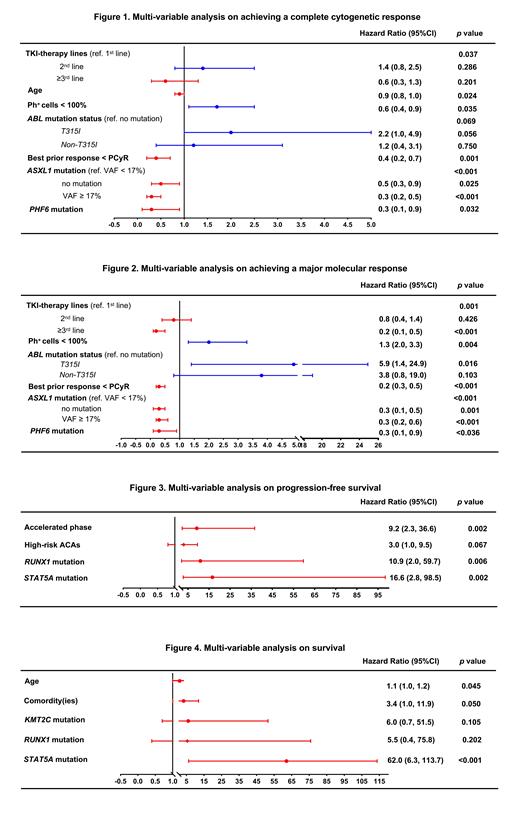Abstract

Background Most, but not everyone with chronic myeloid leukaemia (CML) responds to imatinib or 2 nd-generation tyrosine kinase-inhibitors (TKIs). Mutations in cancer-related genes and in other than ABL1 may explain variable responses and outcomes to the 3 rd-generation TKIs including ponatinib and olverembatinib.
Aim Interrogate correlations between mutations in cancer-related genes and therapy responses and outcomes to 3 rd-generation TKIs.
Methods We used deep targeted sequencing for cancer-related mutations and Sanger sequencing for BCR::ABL1 on DNA samples from 167 subjects with CML failing to the prior imatinib and/or 2 nd-generation TKI-therapy and just before receiving a 3 rd-generation TKI. Gene ontology (GO) analysis was used to evaluate functional enrichment in GO terms among mutated genes. Optimal cut-offs for variant allele frequencies (VAFs) of the common mutations were determined by analyzing receiver-operator characteristic (ROC) curves. A Cox multi-variable regression model was used to identify correlations between mutations in cancer-related genes and therapy responses and outcomes of 3 rd-generation TKI-therapy.
Results 167 subjects in chronic phase (n = 125) and accelerated phase (n = 42) received ponatinib (n = 28) or olverembatinib (n = 139) therapy. 27 subjects were exposed to imatinib; 79, a 2 nd-generation TKI; 61, imatinib and a 2 nd generation TKI. 142 (85%) subjects had ABL1 mutations including ABL1T315I (n = 116) or others (n = 26). 163 subjects had other cancer-related mutations which were evaluated in epigenetic regulators (n = 150), transcription factors (n = 84), cell signaling (n = 42), tumor suppressors (n = 39), protein kinases (n = 27), chromatin modification (n = 9) and DNA damage repair (n = 3) related-genes according to functional enrichment. The top 10 mutations were ASXL1 (n = 115), RUNX1 (n = 12), KMT2D (n = 12), PHF6 (n = 8), KMT2C (n = 8), IKZF1 (n = 8), STAT5A (n = 8), DNMT3A (n = 7), TET2 (n = 6) and BCOR (n = 6). 20 subjects had high-risk additional chromosomal abnormalities (ACAs). Frequency of BCR::ABL1 mutations was inversely- (p < 0.001) and of cancer-related mutations directly-related (p = 0.009) to increasing exposure to prior TKI therapies. These relationships were especially so for mutations in KMT2C (p = 0.06), DNMT3A (p = 0.09), KDM6A (p = 0.06) and TNFAIP3 (p = 0.08). BCR::ABL1 (82% vs. 95%, p = 0.03), RUNX1 (5% vs. 14%, p = 0.04), KMT2C (3% vs. 10%, p = 0.08) and IKZF1 (3% vs. 10%, p = 0.10) were more common in accelerated phase. With a median follow-up of 34 months (interquartile range [IQR], 12-40 months), 95 and 71 subjects achieved a complete cytogenetic response (CCyR) and major molecular response (MMR). 18 subjects transformed to accelerated (n = 8) or blast (n = 10) phases, 16 died of disease progression (n = 12) or other causes (n = 4). 3-year cumulative incidences of CCyR and MMRwere 65% (95% Confidence Interval [CI], 58, 71%) and 52% (43, 61%). 3-year probabilities of progression-free survival (PFS) and survival were 88% (81, 92%) and 91% (85, 95%). Mutations in tumor suppressor genes were more common in subjects not achieving a CCyR (27% vs. 19%, p = 0.01). In multi-variable analyses ASXL1 mutation with a VAF ≥ 17% and a PHF6 mutation were significantly associated with lower cumulative incidences of CCyR (p < 0.001 and p = 0.032) and MMR (p < 0.001 and p = 0.04). Moreover, subjects with BCR-ABL1T315I mutation had significantly higher cumulative incidences of CCyR (p = 0.07) and MMR (p = 0.04) than those with no BCR-ABL1 mutation and other BCR-ABL1 non-T315I mutation. Increasing age, more Ph 1-chromosome-positive cells, the best prior therapy-response < partial cytogenetic response (PCyR) and more TKI-therapies were associated with poor responses. STAT5A mutation was significantly associated with worse PFS (p = 0.002) and survival (p < 0.001), RUNX1 mutation (p = 0.006), high-risk ACAs (p = 0.07) and accelerated phase (p = 0.002) with worse PFS and increasing age (p = 0.05) and comorbidity(ies) (p = 0.05) with wosre survival.
Conclusions ASXL1 mutations with a VAF ≥ 17% and PHF6 mutations were associated with poor responses of the 3 rd-generation TKI-therapy. STAT5A and RUNX1 mutations and high-risk ACAs were also associated with worse outcomes in persons receiving a 3 rd-generation TKI. These data should help physicians select people to receive 3 rd-generation TKIs.
No relevant conflicts of interest to declare.
Author notes
 This icon denotes a clinically relevant abstract
This icon denotes a clinically relevant abstract


This feature is available to Subscribers Only
Sign In or Create an Account Close Modal